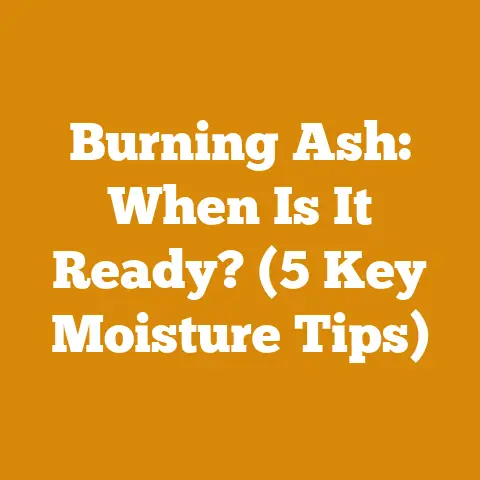Is It OK to Burn Pressure Treated Lumber? (7 Toxic Dangers)
In many parts of the world, the crisp air of autumn signals not only the changing of leaves but also the start of wood-burning season. I’ve always found a certain satisfaction in the process – from the initial felling of a tree to the final crackle and warmth of a well-stocked fire. It’s a tradition passed down through generations, deeply connected to self-sufficiency and resourcefulness. However, this connection to nature also comes with a responsibility to understand the materials we’re using and the potential impact they have on our health and environment.
For years, I’ve helped folks navigate the complexities of wood processing, from choosing the right chainsaw to understanding the nuances of wood moisture content. One question that keeps popping up, especially as people look for affordable fuel sources, is, “Is it okay to burn pressure-treated lumber?” The short answer is a resounding NO. But the reasons why are more complex and concerning than many realize. This guide will dive deep into the toxic dangers of burning pressure-treated wood, providing you with the technical knowledge and practical advice to keep yourself, your family, and your community safe.
The Uneasy Truth: Why Burning Pressure-Treated Lumber is a Bad Idea
Burning wood is an age-old practice, but not all wood is created equal. Pressure-treated lumber, specifically, is a material designed for longevity and resistance to decay, achieved through chemical impregnation. These chemicals, while effective at preserving the wood, become incredibly hazardous when combusted.
The History of Pressure Treatment: A Necessary Evil?
To fully grasp the danger, it’s essential to understand the history and purpose of pressure treatment. Wood, in its natural state, is susceptible to rot, insect infestation, and fungal decay, especially when exposed to moisture and soil. Pressure treatment was developed to combat these vulnerabilities, extending the lifespan of wood used in outdoor applications like decks, fences, and landscaping.
Early pressure treatments relied heavily on chromated copper arsenate (CCA). I remember the days when CCA-treated wood was ubiquitous. It was inexpensive and highly effective. However, the arsenic component raised serious concerns about human health and environmental contamination.
Over time, CCA was phased out in residential applications, replaced by newer treatments like alkaline copper quaternary (ACQ) and copper azole (CA). While these newer formulations are considered less toxic than CCA, they still pose significant risks when burned. The copper, in particular, can create harmful dioxins during combustion.
The 7 Toxic Dangers of Burning Pressure-Treated Lumber
Here’s a breakdown of the specific health and environmental hazards you face when burning pressure-treated wood:
-
Arsenic Exposure: Even though CCA is largely phased out, older structures may still contain this wood. Burning CCA-treated lumber releases arsenic into the air as a fine particulate matter. Inhaling arsenic can lead to various health problems, including:
- Respiratory irritation
- Skin lesions
- Increased risk of lung, bladder, and skin cancers
- Neurological damage
Data Point: Studies have shown that burning CCA-treated wood can release arsenic concentrations in the smoke that are hundreds of times higher than safe exposure limits. 2. Chromium Toxicity: Chromium, another component of CCA, can exist in multiple forms. Chromium(VI) is a known carcinogen, and burning CCA-treated wood can convert other forms of chromium into Chromium(VI), increasing the risk of:
- Respiratory problems
- Skin allergies
- Cancer
-
Copper Poisoning: Newer pressure treatments contain copper compounds. Burning copper-treated wood releases copper oxide particles into the air. Inhaling copper oxide can cause:
-
Metal fume fever (flu-like symptoms)
- Respiratory irritation
- Gastrointestinal problems
-
Dioxin Formation: The high temperatures and incomplete combustion of pressure-treated wood can lead to the formation of dioxins and furans. These are highly toxic and persistent environmental pollutants. Dioxins are known carcinogens and can cause:
-
Immune system suppression
- Reproductive problems
- Developmental issues
- Ash Contamination: The ash left over from burning pressure-treated wood is highly toxic and contains concentrated levels of the chemicals used in the treatment process. Improper disposal of this ash can contaminate soil and water sources.
Data Point: Ash from burning pressure-treated wood can contain arsenic levels exceeding 100 parts per million, far above the EPA’s recommended limit for residential soil. 6. Air Pollution: Burning any type of wood contributes to air pollution, but burning pressure-treated wood releases a particularly harmful cocktail of chemicals and particulate matter. This can exacerbate respiratory problems, especially for individuals with asthma or other lung conditions.
Data Point: According to the EPA, wood-burning stoves and fireplaces are a significant source of fine particulate matter (PM2.5) pollution, which can penetrate deep into the lungs and cause serious health problems. Burning pressure treated wood amplifies this problem. 7. Corrosion of Heating Appliances: The corrosive nature of the chemicals released during combustion can damage stoves, fireplaces, and chimneys. This can lead to costly repairs and increase the risk of chimney fires.
Case Study: The Deck Demolition Debacle
I once consulted on a project where a homeowner decided to demolish an old deck and burn the wood in their backyard fire pit. They figured, “It’s just wood, right?” Thankfully, a neighbor who knew a bit about wood treatment cautioned them.
Upon inspection, I confirmed the deck was built with CCA-treated lumber. The homeowner was shocked. They had no idea they were about to release a cloud of toxic chemicals into their neighborhood. We arranged for proper disposal of the wood at a hazardous waste facility, averting a potential health crisis.
This experience hammered home the importance of educating people about the dangers of burning pressure-treated wood. It’s not enough to simply say “don’t do it.” People need to understand the science behind the warning.
Identifying Pressure-Treated Lumber: What to Look For
Before you even consider burning any wood, you need to be able to identify whether it’s been pressure-treated. Here are some key indicators:
- Color: Pressure-treated lumber often has a greenish or brownish tint, although this can fade over time.
- Stamps and Markings: Look for stamps on the wood that indicate it has been pressure-treated. These stamps may include abbreviations like “CCA,” “ACQ,” or “CA,” as well as information about the treatment level and the company that performed the treatment.
- End Tags: Many pieces of pressure-treated lumber have end tags attached that provide information about the treatment process.
- Nail Patterns: Decks built with pressure treated wood tend to use non-corrosive nails.
- Age: Older lumber is more likely to be treated with CCA. If you’re unsure about the treatment history of a piece of wood, it’s best to err on the side of caution and assume it’s pressure-treated.
- Location of Use: Wood used in ground contact, like fence posts or retaining walls, is almost always pressure-treated.
Safe Disposal of Pressure-Treated Lumber: Doing the Right Thing
If you have pressure-treated lumber that you need to dispose of, it’s crucial to do so responsibly. Here are your options:
- Hazardous Waste Facility: The best option is to take the wood to a hazardous waste facility. These facilities are equipped to handle treated wood safely and prevent environmental contamination.
- Landfill: In some cases, landfills may accept pressure-treated wood. However, it’s essential to check with your local landfill to confirm their policies.
- Reuse: If the wood is still in good condition, consider reusing it for a non-structural application where it won’t come into contact with soil or water.
- Do NOT Burn: Under any circumstances, do not burn pressure-treated lumber. The risks to your health and the environment are simply too great.
Understanding Wood Moisture Content: The Key to Safe and Efficient Burning
While we’re on the topic of safe wood burning, it’s important to discuss wood moisture content. Burning wood that is too wet not only produces less heat but also creates more smoke and creosote buildup in your chimney, increasing the risk of chimney fires.
Measuring Moisture Content: Tools and Techniques
The ideal moisture content for firewood is below 20%. Here are some ways to measure it:
-
Moisture Meter: A moisture meter is a handheld device that measures the electrical resistance of wood. Lower resistance indicates higher moisture content. Insert the probes into a freshly split piece of wood for an accurate reading.
Technical Specification: Look for a moisture meter with a range of 6% to 40% and an accuracy of +/- 1%. * The “Knock” Test: Seasoned firewood will produce a hollow sound when two pieces are knocked together. Wet wood will sound dull. * Visual Inspection: Seasoned firewood will have cracks in the end grain and will be lighter in weight than wet wood. * Soap Bubbles: Apply soapy water to the end grain of the wood. If bubbles form when you blow on it, the wood is still wet. * Kiln Drying: A kiln uses heat to dry wood quickly and uniformly. This method is often used for commercial firewood production.
Seasoning Firewood: The Art of Patient Drying
Seasoning firewood is the process of drying it to reduce its moisture content. Here’s how to do it properly:
- Split the Wood: Splitting the wood increases its surface area, allowing it to dry more quickly.
- Stack it Loosely: Stack the wood in a single row, allowing air to circulate freely.
- Elevate the Stack: Place the wood on pallets or other supports to keep it off the ground.
- Cover the Top: Cover the top of the stack with a tarp to protect it from rain and snow, but leave the sides open for ventilation.
- Location, Location, Location: Place the stack in a sunny and windy location for optimal drying.
Data Point: Hardwoods like oak and maple typically take 6-12 months to season properly, while softwoods like pine and fir may take 3-6 months.
The Science of Wood Drying
Wood drying is governed by the principles of diffusion. Moisture moves from areas of high concentration (the interior of the wood) to areas of low concentration (the surrounding air). The rate of drying is influenced by factors such as temperature, humidity, and air circulation.
Understanding these principles can help you optimize your firewood seasoning process. For example, increasing air circulation by using a fan can significantly reduce drying time.
Case Study: The Firewood Fiasco
A friend of mine, eager to save money on heating bills, decided to cut down a large oak tree in his backyard and burn it immediately. He hadn’t seasoned the wood at all.
The result? His fireplace produced copious amounts of smoke, filled his house with a pungent odor, and barely generated any heat. He also ended up with a thick layer of creosote in his chimney, which required a professional cleaning.
Seasoning your wood properly is not just about convenience; it’s about safety and efficiency.
Choosing the Right Wood: A Guide to Hardwoods and Softwoods
Not all wood burns the same. Hardwoods and softwoods have different properties that affect their burning characteristics.
Hardwoods: The Long-Burning Champions
Hardwoods, such as oak, maple, ash, and birch, are denser and burn longer than softwoods. They also produce more heat and less smoke. However, they take longer to season.
- Oak: A dense, long-burning hardwood that produces excellent heat.
- Maple: A good all-around hardwood that burns cleanly and produces a pleasant aroma.
- Ash: Easy to split and burns well, even when slightly damp.
- Birch: Burns quickly but produces good heat and a bright flame.
Softwoods: The Quick-Burning Kindling
Softwoods, such as pine, fir, and spruce, are less dense and burn more quickly than hardwoods. They also produce more smoke and creosote. Softwoods are best used for kindling or starting fires.
- Pine: Burns quickly and produces a lot of heat, but also creates a lot of smoke and creosote.
- Fir: Similar to pine, but slightly less resinous.
- Spruce: Burns quickly and cleanly, but doesn’t produce as much heat as other softwoods.
Wood Selection Criteria
When choosing firewood, consider the following factors:
- Density: Denser woods burn longer and produce more heat.
- Moisture Content: Aim for a moisture content below 20%.
- Resin Content: Resinous woods produce more smoke and creosote.
- Availability: Choose wood that is readily available in your area.
Chainsaw Safety and Maintenance: A Logger’s Perspective
As someone who has spent countless hours in the woods, I can’t overemphasize the importance of chainsaw safety. A chainsaw is a powerful tool, but it can also be incredibly dangerous if not used properly.
Essential Safety Gear
- Helmet: Protects your head from falling branches and debris.
- Eye Protection: Safety glasses or a face shield protect your eyes from sawdust and flying chips.
- Hearing Protection: Earplugs or earmuffs protect your hearing from the loud noise of the chainsaw.
- Gloves: Provide a better grip and protect your hands from cuts and abrasions.
- Chainsaw Chaps: These are essential for protecting your legs from chainsaw cuts. They are made of ballistic nylon that jams the chain if it comes into contact with the fabric.
- Steel-Toed Boots: Protect your feet from falling logs and chainsaw cuts.
Chainsaw Maintenance: Keeping Your Saw in Top Condition
Regular maintenance is essential for ensuring your chainsaw operates safely and efficiently.
-
Chain Sharpening: A sharp chain is safer and more efficient. Sharpen the chain regularly using a chainsaw file or a chain grinder.
Technical Specification: Maintain a 30-degree angle for the top plate and a 60-degree angle for the side plate. * Chain Tension: Check the chain tension before each use. The chain should be snug but still able to be pulled around the bar by hand. * Bar Lubrication: Keep the bar lubricated with chainsaw bar oil. This reduces friction and wear on the chain and bar. * Air Filter Cleaning: Clean the air filter regularly to ensure proper engine performance. * Spark Plug Inspection: Inspect the spark plug regularly and replace it if necessary. * Fuel Mixture: Use the correct fuel mixture as specified by the chainsaw manufacturer.
Chainsaw Calibration Standards
Proper chainsaw calibration is essential for optimal performance and safety. This includes:
- Idle Speed Adjustment: Adjust the idle speed so the chain doesn’t move when the saw is idling.
- High-Speed Adjustment: Adjust the high-speed mixture for optimal power and performance.
- Chain Oiler Adjustment: Adjust the chain oiler to ensure adequate lubrication of the chain and bar.
Practical Tips for Safe Chainsaw Operation
- Read the Manual: Familiarize yourself with the chainsaw’s operating manual before using it.
- Start the Saw on the Ground: Never drop-start a chainsaw.
- Use a Firm Grip: Hold the chainsaw firmly with both hands.
- Maintain a Stable Stance: Keep your feet firmly planted on the ground.
- Cut at a Safe Distance: Keep a safe distance from other people and obstacles.
- Be Aware of Kickback: Kickback is a sudden and violent reaction that can occur when the tip of the chainsaw bar comes into contact with an object. Be aware of the risk of kickback and take steps to avoid it.
- Take Breaks: Chainsaw operation can be tiring. Take frequent breaks to avoid fatigue.
- Never Cut Above Your Head: This is extremely dangerous and should be avoided at all costs.
- Don’t Work Alone: Always have someone nearby in case of an emergency.
Case Study: The Near Miss
I once witnessed a near-fatal accident involving a chainsaw. A young logger was cutting down a tree when the chainsaw kicked back, striking him in the leg. Fortunately, he was wearing chainsaw chaps, which prevented a serious injury.
This incident served as a stark reminder of the importance of chainsaw safety. Even experienced loggers can make mistakes. It’s crucial to always be vigilant and follow safe operating procedures.
Conclusion: A Responsible Approach to Wood Burning
Burning wood can be a rewarding and sustainable way to heat your home, but it’s essential to do it responsibly. Avoid burning pressure-treated lumber at all costs, and always prioritize safety when handling wood and operating chainsaws. By understanding the science behind wood burning and following best practices, you can enjoy the warmth and comfort of a wood fire without compromising your health or the environment. Remember, a little knowledge and caution can go a long way in ensuring a safe and enjoyable wood-burning season.






